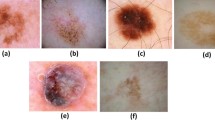Abstract
Purpose
Computerized prescreening of suspicious moles and lesions for malignancy is of great importance for assessing the need and the priority of the removal surgery. Detection can be done by images captured by standard cameras, which are more preferable due to low cost and availability. One important step in computerized evaluation is accurate detection of lesion’s region, i.e., segmentation of an image into two regions as lesion and normal skin.
Methods
In this paper, a new method based on deep neural networks is proposed for accurate extraction of a lesion region. The input image is preprocessed, and then, its patches are fed to a convolutional neural network. Local texture and global structure of the patches are processed in order to assign pixels to lesion or normal classes. A method for effective selection of training patches is proposed for more accurate detection of a lesion’s border.
Results
Our results indicate that the proposed method could reach the accuracy of 98.7% and the sensitivity of 95.2% in segmentation of lesion regions over the dataset of clinical images.
Conclusion
The experimental results of qualitative and quantitative evaluations demonstrate that our method can outperform other state-of-the-art algorithms exist in the literature.








Similar content being viewed by others
References
American Cancer Society (2016) Cancer facts & figures 2016. American Cancer Society, Atlanta
Skincancer.org. http://www.skincancer.org/skin-cancer-information/skin-cancer-facts
Jerant AF, Johnson JT, Sheridan C, Caffrey TJ (2000) Early detection and treatment of skin cancer. Am Fam Physician 2:357–386
Nachbar F, Stolz W, Merkle T, Cognetta AB, Vogt T, Landthaler M, Bilek P, Falco OB, Plewig G (1994) The abcd rule of dermatoscopy: high prospective value in the diagnosis of doubtful melanocytic skin lesions. J Am Acad Dermatol 30:551–559
Korotkov K, Garcia R (2012) Computerized analysis of pigmented skin lesions: a review. Artif Intell Med 56:69–90
Engasser H, Warshaw E (2010) Dermatoscopy use by US dermatologists: a cross-sectional survey. J Am Acad Dermatol 63:412–419
Amelard R, Glaister J, Wong A, Clausi D (2015) High-level intuitive features (HLIFs) for intuitive skin lesion description. IEEE Trans Biomed Eng 62:820–831
Jafari MH, Samavi S, Soroushmehr SMR, Mohaghegh H, Karimi N, Najarian K (2016) Set of descriptors for skin cancer diagnosis using non-dermoscopic color images. In: 2016 IEEE international conference on image processing (ICIP)
Glaister J (2013) Automatic segmentation of skin lesions from dermatological photographs. M.S. thesis Department of Systems Design Engineering, University of Waterloo, Waterloo
Celebi M, Kingravi H, Iyatomi H, Alp Aslandogan Y, Stoecker W, Moss R, Malters J, Grichnik J, Marghoob A, Rabinovitz H, Menzies S (2008) Border detection in dermoscopy images using statistical region merging. Skin Res Technol 14:347–353
Celebi M, Iyatomi H, Schaefer G, Stoecker W (2009) Lesion border detection in dermoscopy images. Comput Med Imaging Graph 33:148–153
Cavalcanti P, Yari Y, Scharcanski J (2010) Pigmented skin lesion segmentation on macroscopic images. In: Procedings of 25th international conference on image vision computing, pp 1–7
Cavalcanti P, Scharcanski J, Lopes C (2010) Shading attenuation in human skin color images. In: 6th International symposium on advances in visual computing, pp 190–198
Cavalcanti P, Scharcanski J (2011) Automated prescreening of pigmented skin lesions using standard cameras. Comput Med Imaging Graph 35:481–491
Glaister J, Wong A, Clausi D (2014) Segmentation of skin lesions from digital images using joint statistical texture distinctiveness. IEEE Trans Biomed Eng 61:1220–1230
Schmidhuber J (2015) Deep learning in neural networks: an overview. Neural Netw 61:85–117
Deng L (2014) Deep learning: methods and applications. FNT Signal Process 7:197–387
Melinščak M, Prentašić P, Lončarić S (2015) Retinal vessel segmentation using deep neural networks. In: 10th International conference on computer vision theory and applications
Nasr-Esfahani E, Samavi S, Karimi N, Soroushmehr SMR, Ward K, Jafari MH, Felfeliyan B, Najarian K (2016) Vessel extraction in X-ray angiograms using deep learning. In: 2016 38th Annual international conference of the IEEE engineering in medicine and biology society (EMBC)
Havaei M, Davy A, Warde-Farley D, Biard A, Courville A, Bengio Y, Pal C, Jodoin P, Larochelle H (2016) Brain tumor segmentation with deep neural networks. Med Image Anal 35:18–31
Zhao R, Ouyang W, Li H, Wang X (2015) Saliency detection by multi-context deep learning. In: IEEE conference on computer vision and pattern recognition (CVPR), pp 1265–1274
Jafari MH, Karimi N, Nasr-Esfahani E, Samavi S, Soroushmehr SMR, Ward K, Najarian K (2016) Skin lesion segmentation in clinical images using deep learning. In: 2016 23rd International conference on pattern recognition (ICPR)
He K, Sun J, Tang X (2013) Guided image filtering. IEEE Trans Pattern Anal Mach Intell 35:1397–1409
Author information
Authors and Affiliations
Corresponding author
Ethics declarations
Conflict of interest
The authors declare that there is no conflict of interest.
Ethical approval
This article does not contain any studies with human participants or animals performed by any of the authors.
Informed consent
This articles does not contain patient data.
Rights and permissions
About this article
Cite this article
Jafari, M.H., Nasr-Esfahani, E., Karimi, N. et al. Extraction of skin lesions from non-dermoscopic images for surgical excision of melanoma. Int J CARS 12, 1021–1030 (2017). https://doi.org/10.1007/s11548-017-1567-8
Received:
Accepted:
Published:
Issue Date:
DOI: https://doi.org/10.1007/s11548-017-1567-8




